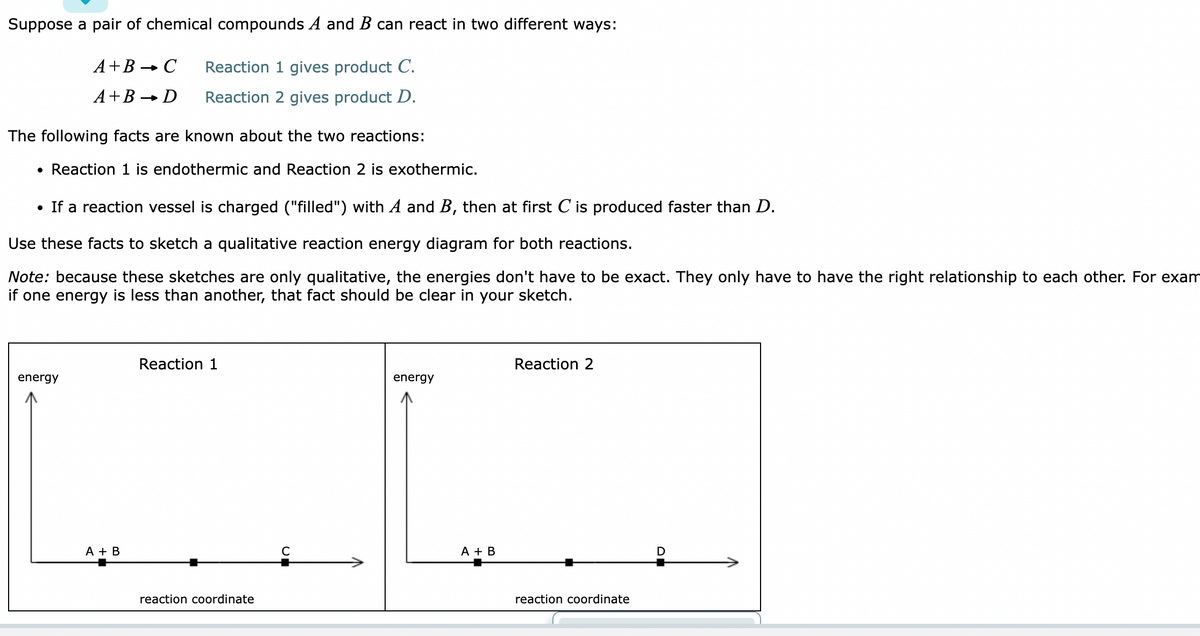a pair of chemical compounds A and B can react in two different ways: A+B C Reaction 1 gives product C. A+B D Reaction 2 gives product D. wing facts are known about the two reactions: action 1 is endothermic and Reaction 2 is exothermic. a reaction vessel is charged ("filled") with A and B, then at first C is produced faster than D. e facts to sketch a qualitative reaction energy diagram for both reactions. cause these sketches are only qualitative, the energies don't have to be exact. They only have to have the right relationship to each other. For exam ergy is less than another, that fact should be clear in your sketch. Reaction 1 Reaction 2 energy reaction coordinate A + B reaction coordinate A + B
a pair of chemical compounds A and B can react in two different ways: A+B C Reaction 1 gives product C. A+B D Reaction 2 gives product D. wing facts are known about the two reactions: action 1 is endothermic and Reaction 2 is exothermic. a reaction vessel is charged ("filled") with A and B, then at first C is produced faster than D. e facts to sketch a qualitative reaction energy diagram for both reactions. cause these sketches are only qualitative, the energies don't have to be exact. They only have to have the right relationship to each other. For exam ergy is less than another, that fact should be clear in your sketch. Reaction 1 Reaction 2 energy reaction coordinate A + B reaction coordinate A + B
Chemistry: The Molecular Science
5th Edition
ISBN:9781285199047
Author:John W. Moore, Conrad L. Stanitski
Publisher:John W. Moore, Conrad L. Stanitski
Chapter16: Thermodynamics: Directionality Of Chemical Reactions
Section: Chapter Questions
Problem 14QRT
Related questions
Question

Transcribed Image Text:Suppose a pair of chemical compounds A and B can react in two different ways:
A+B → C
Reaction 1 gives product C.
A+B → D
Reaction 2 gives product D.
The following facts are known about the two reactions:
●
Reaction 1 is endothermic and Reaction 2 is exothermic.
• If a reaction vessel is charged ("filled") with A and B, then at first C is produced faster than D.
Use these facts to sketch a qualitative reaction energy diagram for both reactions.
Note: because these sketches are only qualitative, the energies don't have to be exact. They only have to have the right relationship to each other. For exam
if one energy is less than another, that fact should be clear in your sketch.
Reaction 1
Reaction 2
energy
energy
reaction coordinate
A + B
A + B
reaction coordinate
D
Expert Solution
This question has been solved!
Explore an expertly crafted, step-by-step solution for a thorough understanding of key concepts.
Step by step
Solved in 3 steps with 3 images

Knowledge Booster
Learn more about
Need a deep-dive on the concept behind this application? Look no further. Learn more about this topic, chemistry and related others by exploring similar questions and additional content below.Recommended textbooks for you

Chemistry: The Molecular Science
Chemistry
ISBN:
9781285199047
Author:
John W. Moore, Conrad L. Stanitski
Publisher:
Cengage Learning

Chemistry & Chemical Reactivity
Chemistry
ISBN:
9781337399074
Author:
John C. Kotz, Paul M. Treichel, John Townsend, David Treichel
Publisher:
Cengage Learning

Chemistry & Chemical Reactivity
Chemistry
ISBN:
9781133949640
Author:
John C. Kotz, Paul M. Treichel, John Townsend, David Treichel
Publisher:
Cengage Learning

Chemistry: The Molecular Science
Chemistry
ISBN:
9781285199047
Author:
John W. Moore, Conrad L. Stanitski
Publisher:
Cengage Learning

Chemistry & Chemical Reactivity
Chemistry
ISBN:
9781337399074
Author:
John C. Kotz, Paul M. Treichel, John Townsend, David Treichel
Publisher:
Cengage Learning

Chemistry & Chemical Reactivity
Chemistry
ISBN:
9781133949640
Author:
John C. Kotz, Paul M. Treichel, John Townsend, David Treichel
Publisher:
Cengage Learning

Living By Chemistry: First Edition Textbook
Chemistry
ISBN:
9781559539418
Author:
Angelica Stacy
Publisher:
MAC HIGHER

General, Organic, and Biological Chemistry
Chemistry
ISBN:
9781285853918
Author:
H. Stephen Stoker
Publisher:
Cengage Learning

General Chemistry - Standalone book (MindTap Cour…
Chemistry
ISBN:
9781305580343
Author:
Steven D. Gammon, Ebbing, Darrell Ebbing, Steven D., Darrell; Gammon, Darrell Ebbing; Steven D. Gammon, Darrell D.; Gammon, Ebbing; Steven D. Gammon; Darrell
Publisher:
Cengage Learning